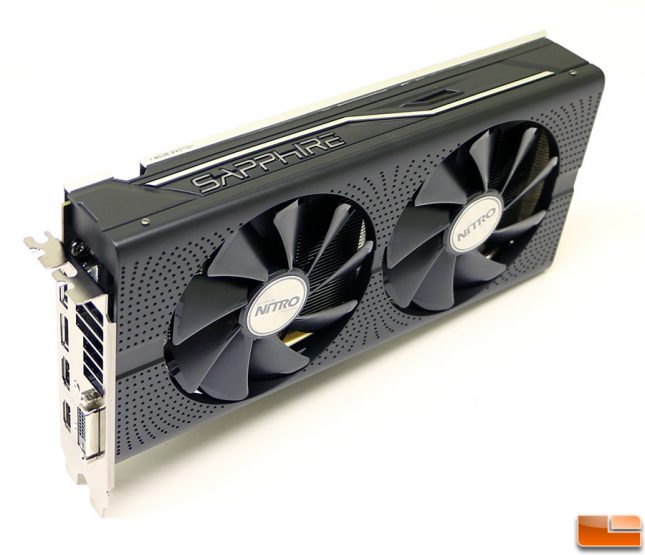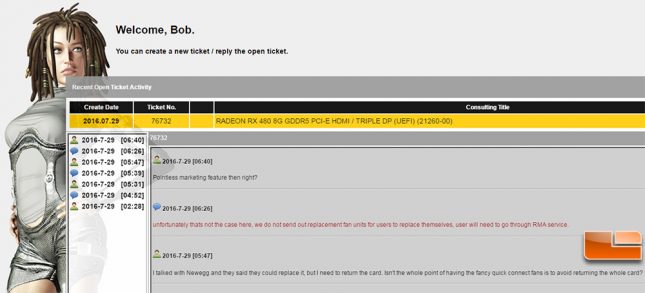Sapphire Nitro Radeon RX 480 4GB Video Card Review
Final Thoughts and Conclusions
The Sapphire Nitro Radeon RX 480 4GB video card is easily one of the most anticipated AMD Radeon branded cards that I have seen in years. Im not sure if Sapphire leaked purposely leaked out images of the early cheese grater version of the Radeon RX480 Nitro with the silver metal fan shroud or not, but it got people talking about the card more than a month before it was announced. The AMD Radeon RX 480 reference design got some negative feedback about how it draws power and the Sapphire Radeon RX 480 was the gem waiting on the sidelines that had an 8-pin PCIe power connector instead of the factory 6-pin power connector. This means that it should be able to easily handle the power demands of AMDs 150W TDP Pascal GPU without leaving gamers concerned with power draws through the x16 PCIe slot or the additional PCIe power connector. Then there was the fact that the stock heatsink on the AMD Radeon RX480 looked puny and left many wanting lower thermals and noise levels. Again, the Sapphire Nitro+ Radeon RX 480 was coming with a massive GPU cooler with three copper heatpipes, a large aluminum fin array and twin fans that are easily removable.
On paper the Sapphire Nitro Radeon RX 480 looks to be a damn near perfect custom designed card by a board partner. After using the Nitro Radeon RX 480 4GB for a very short period of time it left me feeling like I boarded the hype train. For starters the performance of this factory overclocked card is lower than that of the Radeon RX 480 8GB reference card despite having a higher boost clock speed of 1306MHz. I knew having 4GB of memory running at just 7Gbps instead of 8Gbps would slightly impact performance, but I thought going from 1266MHz on the core clock to 1306MHz would easily make up for that. The performance of the card felt the same when I played games, but when running the benchmarks I learned that they were coming out slightly lower. That was totally unexpected, but the good news is the card isn’t significantly slower than the AMD Radeon RX 480 8GB reference card and it costs less.
The GPU cooler on the Sapphire Nitro Radeon RX 480 4GB looks impressive and that it would be night and day better than the reference design. When I first powered on the open air test system it was running around 30C on the desktop and then it slowly climbed to 40C and then proceeded to go all the way up to 54C and that I when the fans on the card kicked on. Sure, the open air test platform has poor airflow, but I have benchmarked many 0dB cards from NVIDIA lately (GeForce GTX 1060 and GeForce GTX 1070) and found that some can stay below 30C at idle. I placed a 120mm fan blowing across the test systems memory and ultimately the back of the Sapphire Nitro Radeon RX 480 4GB and was able to get the temps down to 45C. Having proper airflow is a must or youll end up with a non-passive solution at idle like we did.
Sapphire has been marketing the easily removable fans as a key differentiating factor, but who benefits? Are there aftermarket clip-in fans that you can buy? If there were such a thing offered how would you load a new fan profile for the new fans as surely the number of fan blades, the pitch of the blades and overall airflow would be different. Building up an entire ecosystem is tough to do and most companies fail at it. Sapphires easily swappable fan design appears to benefit them the most. If a fan fails during the warranty period or arrives damaged they can quickly send you out a new one via first class mail. Before theyd have to send you a whole new fan shroud with the fans attached or get the card back and do the repairs and then send the card back to you and pay standard shipping rates. This will save the company money and reduce the number of used RMA cards that have been fixed and need to be re-sold somewhere. Nothing wrong with that and it is a marketable feature as repairing a failed card quicker would be nice.
I wanted to see if I could get a replacement fan and setup an account see how Sapphire customer support would handle my trouble ticket. We made up a fake account, so Sapphire customer support wouldn’t know it was us and told them that our parents gave us a Nitro Radeon RX 480 4GB video card from Newegg and that one of the two fans was squeaky. They told us that we needed to send it back to Newegg for replacement. When I pushed them about replacing just the fan they quickly replied they don’t send fans out. When asked if it was just a pointless marketing feature they responded saying that is how the standard RMA process works. So, the only point of the removable fans is cleaning the heatsink fins out? You can remove the entire fan shroud assembly easily to do that since it’s just held on with a handful of Philips screws.
The Sapphire Nitro RX 480 4GB video card has left me with mixed feelings. I had high hopes for this card as Sapphire really touted it up. Its a good card, but I was expecting more from this custom board. It doesnt have any choke whine and appears to be well built, but the GPU cooler just didnt do enough for me and that is one of the big reasons for buying a custom card. Weeks ago I watched and tuned in for the Sapphire Nation pod casts and Ed from their North American PR department and saw that he genuinely excited by the card. Im sure other review sites will praise the removable fans and the GPU cooler for being cooler overall than the reference design, but it failed to impress this veteran hardware reviewer. Ed is generally spot on with his thoughts as he is a gamer and he himself was a hardware reviewer. The only problem is when he started to talk about the card he didnt have a sample and he was basing his thoughts off what he knew internally and the same information we were seeing from corporate.
Gaming performance on the Sapphire Nitro Radeon RX 480 4GB looked pretty good and Sapphire is targeting this model at 1080P gamers whereas they feel the 8GB model is more for 1440P gamers or those that are wanting to run CrossFire. Our testing showed that a Radeon RX 480 4GB card is just as good at 1440P gaming as the 8GB version, so save yourself some money. Having a pair of Radeon RX 480 8GB cards is certainly the ideal solution for a multi-GPU CrossFire setup due to being able to utilize 8GB of memory between the two cards. The Sapphire Nitro Radeon RX 480 4GB should be a solid card for 1080P gamers that want to play with high settings or 1440P gamers that are okay with middle of the road image quality settings. The performance difference between the 4GB models and 8GB models are pretty minor as we showed you last month.
Overclocking performance was pretty decent as we were able to take the core clock speed from 1306MHz all the way up to 1370MHz with full stability. This is above the 1342MHz core clock found on the Sapphire Nitro Radeon RX 480 8GB model that costs $50 more, so we are happy with that. Sapphire is using slower 7000 MHz memory on the Nitro Radeon RX 480 4GB video card and overclocking it to 8000 MHz was out of the question.
When it comes to pricing the Sapphire Nitro Radeon RX 480 4GB is $219 versus the $199 price point on AMDs reference card. The Nitro Radeon RX 480 8GB is $269, so you need to cough up $50 for the extra 4GB of GDDR5 memory, higher boost clock and higher memory clock speed. Sapphire also informed us that they bin their cards so the 4GB cards are going to be the fallout from the 8GB cards. Does that make it worth spending an extra $50 for? Tough call as the NVIDIA GeForce GTX 1060 6GB video card price range starts at $249.
Legit Bottom Line: The Sapphire Nitro Radeon RX 480 4GB graphics card had decent performance, but didn’t leave us with that wow feeling due to what seemed like high temperature and fan noise issues.


